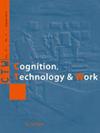Frequency of musculoskeletal complaints and their associated risk factors among computer workers.
IF 3.4
3区 工程技术
Q2 ENGINEERING, INDUSTRIAL
引用次数: 0
Abstract
BACKGROUND Computer-related work has become a part of the daily routine of workers of many occupations which leads to pains of multiple parts of the musculoskeletal system. OBJECTIVES To examine the frequency and severity of musculoskeletal complaints of different regions of the body, and to examine the relationship between work-related risk factors with musculoskeletal complaints. METHODS Three hundred and twenty-six computer workers were selected by non-probability purposive sampling from three clusters of computer sectors. The study design was a descriptive cross-sectional study. Respondents were interviewed and their height and weight were measures. Confidentiality was assured. RESULTS The most common musculoskeletal complaints were shoulder (45% ), neck (43% ), and upper-middle back (36%) pain. The complaints were related to the female gender, increase duration of computer and using a computer at home. CONCLUSIONS Musculoskeletal complaints and psychosocial stresses were related to increasing the duration of computer work.计算机工作者肌肉骨骼疾患的频率及其相关危险因素。
与计算机相关的工作已成为许多职业工人日常工作的一部分,导致肌肉骨骼系统的多个部位疼痛。目的了解不同部位肌肉骨骼疾患的发生频率和严重程度,探讨与工作相关的危险因素与肌肉骨骼疾患的关系。方法采用非概率目的抽样方法,从计算机行业的三个分组中抽取326名计算机从业人员。研究设计为描述性横断面研究。受访者接受了采访,并测量了他们的身高和体重。保密得到保证。结果最常见的肌肉骨骼疾病是肩痛(45%)、颈痛(43%)和上背部疼痛(36%)。投诉主要与女性、电脑使用时间延长和在家使用电脑有关。结论电脑工作时间的增加与肌肉骨骼疾病和心理社会压力有关。
本文章由计算机程序翻译,如有差异,请以英文原文为准。
求助全文
约1分钟内获得全文
求助全文
来源期刊

Cognition Technology & Work
ENGINEERING, INDUSTRIAL-
CiteScore
6.90
自引率
7.70%
发文量
26
审稿时长
>12 weeks
期刊介绍:
Cognition, Technology & Work focuses on the practical issues of human interaction with technology within the context of work and, in particular, how human cognition affects, and is affected by, work and working conditions.
The aim is to publish research that normally resides on the borderline between people, technology, and organisations. Including how people use information technology, how experience and expertise develop through work, and how incidents and accidents are due to the interaction between individual, technical and organisational factors.
The target is thus the study of people at work from a cognitive systems engineering and socio-technical systems perspective.
The most relevant working contexts of interest to CTW are those where the impact of modern technologies on people at work is particularly important for the users involved as well as for the effects on the environment and plants. Modern society has come to depend on the safe and efficient functioning of a multitude of technological systems as diverse as industrial production, transportation, communication, supply of energy, information and materials, health and finance.
 求助内容:
求助内容: 应助结果提醒方式:
应助结果提醒方式:


